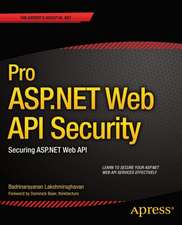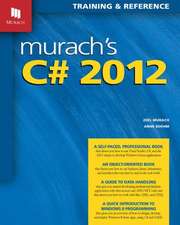Learning to Build and Comprehend Complex Information Structures: Prolog as a Case Study: Contemporary Studies in Cognitive Science and Technology
Autor Paul Brna, Benedict Du Boulay, Helen Painen Limba Engleză Hardback – 12 aug 1999 – vârsta până la 17 ani
| Toate formatele și edițiile | Preț | Express |
|---|---|---|
| Paperback (1) | 268.39 lei 6-8 săpt. | |
| Bloomsbury Publishing – 9 aug 1999 | 268.39 lei 6-8 săpt. | |
| Hardback (1) | 466.07 lei 6-8 săpt. | |
| Bloomsbury Publishing – 12 aug 1999 | 466.07 lei 6-8 săpt. |
Preț: 466.07 lei
Preț vechi: 605.57 lei
-23% Nou
Puncte Express: 699
Preț estimativ în valută:
89.18€ • 93.36$ • 73.79£
89.18€ • 93.36$ • 73.79£
Carte tipărită la comandă
Livrare economică 05-19 aprilie
Preluare comenzi: 021 569.72.76
Specificații
ISBN-13: 9781567504347
ISBN-10: 1567504345
Pagini: 430
Dimensiuni: 156 x 235 x 24 mm
Greutate: 0.74 kg
Editura: Bloomsbury Publishing
Colecția Praeger
Seria Contemporary Studies in Cognitive Science and Technology
Locul publicării:New York, United States
ISBN-10: 1567504345
Pagini: 430
Dimensiuni: 156 x 235 x 24 mm
Greutate: 0.74 kg
Editura: Bloomsbury Publishing
Colecția Praeger
Seria Contemporary Studies in Cognitive Science and Technology
Locul publicării:New York, United States
Notă biografică
PAUL BRNA is Reader in Interactive Learning Systems in the Computer Based Learning Unit at the University of Leeds./e Paul works on the applications of Artificial Intelligence to Education, including research into the interpretation and use of external representations and narrative in collaborative program construction and debugging.BENEDICT DU BOULAY is Professor of Artificial Intelligence Subject Group within the School of Cognitive and Computer Sciences. He is a member of the Human Centred Technology Research Group working in the areas of Artificial Intelligence in Education and the Psychology of Programming, University of Sussex.HELEN PAIN is Senior Lecturer at the Division of Informatics, University of Edinburgh.
Cuprins
AcknowledgmentsPart I: Introduction, Paul Brna, Benedict du Boulay, and Helen PainBuilding and Manipulating Complex Information Structures: Issues in Prolog Programming, Thomas GreenDetecting Design Decisions About Data Structures in Prolog Programs, Diana BentalAnalyzing Novices Analyzing Prolog: What stories do novices tell themselves about Prolog? Josie TaylorTowards a Taxonomy of Novices' Misconceptions of the Prolog Interpreter, Pat Fung, Mike Brayshaw, Benedict du Boulay, and Mark Elsom-CookThe Use of Examples in Expository Texts: Outline of an Interpretation Theory for Text Analysis, Ian Robertson.Part II: Intermediate Representations: Effective Support for Novice Programmers? Paul BrnaProgramming Techniques for Prolog, Paul Brna, Alan Bundy, Tony Dodd, Marc Eisenstadt, Chee-Kit Looi, Helen Pain, Dave Robertson, Barbara Smith, and Maarten van SomersonIntroductory Prolog: A Suitable Selection of Programming Techniques, Andy Bowles and Paul BrnaAn Empirical Evaluation of Ted, A Techniques Editor for Prolog Programming, Thomas C. Ormerod and Linden J. BallA Case-Based Reasoning Approach to Supporting Novice Programmers, Andy Bowles, Dave Robertston, and Paul BrnaPart III: Support for Program Analysis, Benedict du BoulayAbstract Views of Prolog Executions in Opium, Mireille DucasséTracing and Debugging Prolog and PARLOG: an information management approachA Revised Textual Tree Trace Notation For Prolog, Chris Taylor, Benedict du Boulay, and Mukesh PatelThe ISM Framework: Understanding and Evaluating Software Visualization Tools, Paul MulhollandSoftware Visualization as a Pedagogical Tool: Redressing Some ITS Fallacies, Marc Eisenstadt, Blaine A. Price, and John DominguePart IV: Teaching and Learning Environments for Novice Programmers, Paul BrnaExploiting Program Schemata to Teach Recursive Programming, Timothy S. Gegg-HarrisonLearning Prolog Debugging Skills, Paul Brna, Edmundo Robert Hernanzes, and Helen PainTeaching Prolog Debugging in a Motivation Manner, Teresa del Soldato and Benedict du BoulayAuthor IndexSubject Index















